VIETNAM
Economy

Economy

Cities in VIETNAM
| Hanoi |
Economy
General
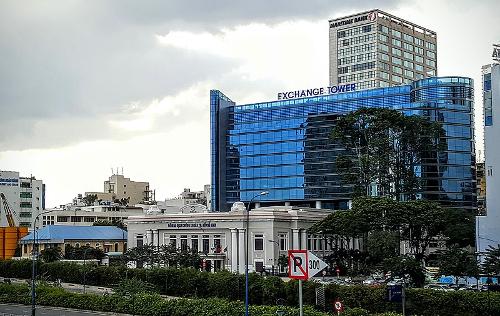 Stock Exchange VietnamPhoto: Trungydang CC 3.0 Unported no changes made
Stock Exchange VietnamPhoto: Trungydang CC 3.0 Unported no changes made
In 1986, the Communist Party of Vietnam decided on a major economic reform process (Doi Moi) and opening up to trade contacts with the West. Full-fledged private companies were allowed in addition to state-owned and collective enterprises. Until then, collective companies were privatized and responsible themselves for profit, loss, purchasing, sales of end products, personnel policy and planning. Other reforms concerned trade, toll controls at provincial borders, tax, banking, labor and prices. Land ownership remained prohibited and foreign investors were given the right to own capital or goods in Vietnam. Companies in which foreign companies invest may not be nationalized.
Due to the success of the Doi Moi, the Vietnamese economy has experienced remarkable growth since 1986. The gross national product (per capita $ 240 in 1995 and $ 400 in 2002) grew by an average of 8.3% per year between 1990 and 1995. Foreign investments amounted to a total of USD 10 billion, mainly in oil and gas, forestry and fishery products and in tourism. Inflation and unemployment (12.7% and 6.1% in 1995 respectively) were on the high side in those years. Currently, the unemployment rate is set at 6% in the cities and less than 1% in the countryside. The national average in 2002 was 2.3%.
Despite the support of the World Bank and the IMF, the Vietnamese economy in 1998 did not escape the financial crisis in Asia, which mainly affected construction, exports and tourism. GDP growth was half under expectations at 4% in 1998, but grew by 6.9% in 2001 and 7% in 2002. Economic growth declined in 1999 to the unprecedented level of 3.5% for many years, while inflation rose to 9%. Foreign direct investment fell to two-thirds of the total in previous years. Falling exports and a trade deficit of 4.5% of GDP in 1999 aggravated the situation, but a balance of payments crisis did not materialize. In the years after 1999, the Vietnamese economy accelerated again and the gross domestic product grew strongly. There is also a strong informal, underground economy, although this is denied by the government. Bureaucracy, corruption, illicit traffic, counterfeiting, prostitution, gambling and drugs are issues that constantly threaten the Vietnamese economy.
In 1995 Vietnam joined ASEAN (Association of Southeast Asian Nations). Despite more lenient conditions for foreign investment, the decline in foreign direct investment that started in 1997 continued. Trade liberalization and reform of loss-making state-owned companies stagnated. Due to a trade agreement in 2001 between the United States and Vietnam and agreements with the IMF and the World Bank, the confidence of foreign investors grew somewhat again. The treaty with the United States provided Vietnam with significantly better access to the American market. In the first quarter of 2003, exports to the United States increased by 43% compared to the same period in 2002. Foreign investment also increased with the establishment of a small stock exchange in Saigon. Ho Chi Minh City is still Vietnam's economic center of gravity with an economic growth of more than 10% per year. Together with the neighboring provinces of Binh Duong and Dong Nai, the entire region accounts for 60% of all foreign investment.
Vietnam joined the World Trade Organization (WTO) in 2007. The share of the agricultural sector in economic production has continued to shrink from about 25% in 2000 to less than 16% in 2013. In the same period, the share of the industry fell from 36% to 33%. The service sector accounts for about 51% of GDP. Poverty has fallen significantly and Vietnam is working to create jobs to keep the workforce growing by more than a million people a year in employment. The global recession hurt the export-oriented economy. GDP will grow by 6.8% in 2017. The GDP per capita was $ 6,900 in 2017.
Agriculture, livestock, forestry and fishing
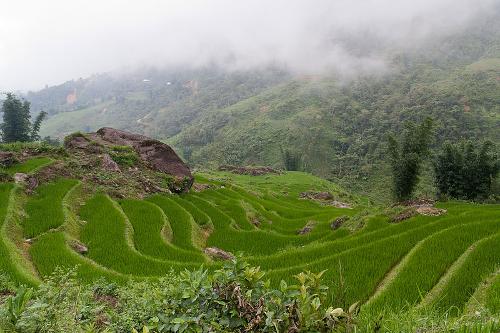 Rice cultivation in Sa Pa, VietnamPhoto: Ekrem Canli CC 3.0 Unported no changes made
Rice cultivation in Sa Pa, VietnamPhoto: Ekrem Canli CC 3.0 Unported no changes made
Only 25% of the area of mountainous Vietnam is suitable for agriculture. The main agricultural area is in the fertile Mekong delta and the Red River delta is also important. Thanks to the successful liberalization of agriculture, Vietnam has now taken second place in the world ranking of rice exporting countries, after Thailand. Rice is grown on about 60% of the agricultural area. Furthermore, Vietnam is the largest exporter of black pepper worldwide. Other important agricultural products are: corn, cotton, fruit, sugar cane, cassava, coffee, tea and rubber. The average farm is small in size and is only 0.7 hectares.
Livestock farming includes pig, chicken and buffalo farming and is mainly focused on domestic consumption. Most dairy cows are bred in the southern provinces.
Approx. 50% of the surface of the north is covered with forests, making timber extraction commercially very attractive. However, timber extraction is regulated to protect the forests, because in 1940 Vietnam had 15 million hectares of forests, today there are less than 8 million.
Vietnam has a coastline of more than 3000 kilometers and an extensive network of rivers, canals and lakes. Coastal and distant fisheries are well developed, as are river fisheries and fish farms (approx. 1 million hectares) in the rice fields, which make an important contribution to the diet. Freshwater fisheries and shrimp farms are particularly profitable. In terms of exports, fishing ranks third behind crude oil and textiles / clothing and the fish processing industry is also expanding very rapidly. The main buyers of Vietnamese fish and fish products are the United States, Japan and the European Union.
Mining and energy
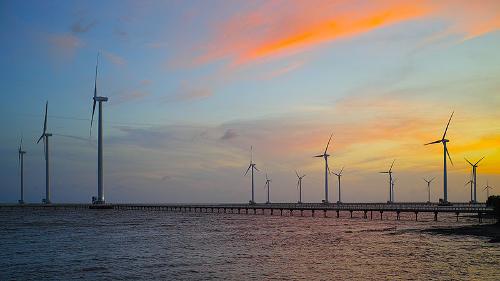 Wind farm, VietnamPhoto: Shansov.net CC 3.0 Unported no changes made
Wind farm, VietnamPhoto: Shansov.net CC 3.0 Unported no changes made
In the north, the coal basins in the hinterland of the port city of Hong Gai are of great importance. The coal reserves mainly consist of anthracite and amount to between seven and eight billion tons, of which about 600 million tons are just below the surface. For the time being, the government prefers the construction of coal-fired power plants instead of hydropower plants, but there is a turnaround towards more sustainable energy sources.
The Vietnamese soil contains iron, bauxite, tin, zinc, chromium, copper, tungsten, lead, gold and manganese ores. Some of these are already being mined, including iron ore, potassium phosphate, chromium and gold. Iron ore reserves are estimated at 560 million tons and those of potassium phosphate, used for fertilizer production, at 1 billion tons. Bauxite could become an important commodity and there are advanced plans to exploit the bauxite reserves for aluminum production.
With the help of the Soviet Union, oil has been extracted off the south coast since 1984, but since the disintegration of that country in 1991, the oil has mainly been extracted by Western companies such as Shell and BP. The Russian Federation did, however, retain an interest in Vietnamese oil, for example through the Vietsorpetro joint venture. An oil refinery is under construction near Ho Chi Minh City. Total natural gas reserves are estimated at 1.3 trillion m3. The largest gas fields are located in the southwest and southeast of the country.
Industry
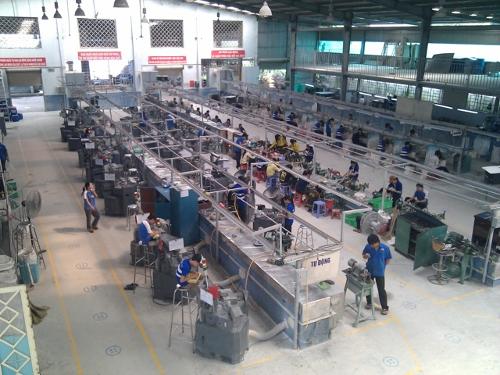 Button factory, textile industry VietnamPhoto: Tophu4u2 CC 3.0 Unported no changes made
Button factory, textile industry VietnamPhoto: Tophu4u2 CC 3.0 Unported no changes made
The industrial sector employs a quarter of the working population, but has less growth than the services sector. The industrial sector is developing slowly and is quite dependent on foreign investment.
The main industrial activities are concentrated in the north and around Ho Chi Minh City. Its main branches are the iron and steel industry, the food and textile industry.
The Vietnamese government gives high priority to the development of heavy industry, especially the steel and automotive industries.
Vietnam has a number of car assembly companies that have entered into joint ventures with foreign companies, including Daewoo, Toyota and Ford.
Trade
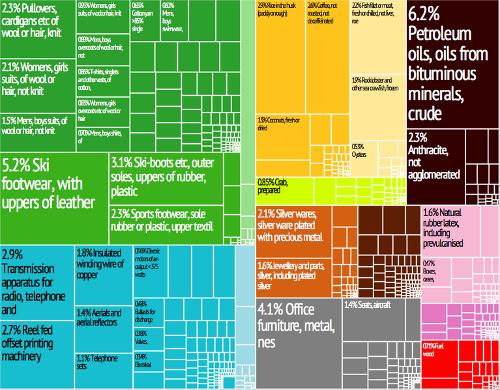 Vietnam ExportPhoto:R. Haussmann, Cesar Hidalgo, et.al. CC 3.0 Unported no changes made
Vietnam ExportPhoto:R. Haussmann, Cesar Hidalgo, et.al. CC 3.0 Unported no changes made
Vietnam's trade surplus has been increasing in recent years due to sharply increased exports. The surplus for 2017 is approximately $ 12 billion.
In 2001, a trade agreement with the United States gave exports a huge boost. Import tariffs in particular fell sharply, causing the United States to replace Japan as the main trading partner. Other export partners are China, South Korea and Malaysia.
The main exports were textiles and clothing, rice and electronics. Total exports were worth $ 214 billion (2017).
The main imports were machines and tools, cars and plastics. Total imports were worth $ 202 billion (2017). The main import partners are China, South Korea, Japan, Singapore and Thailand.
ICT-sector
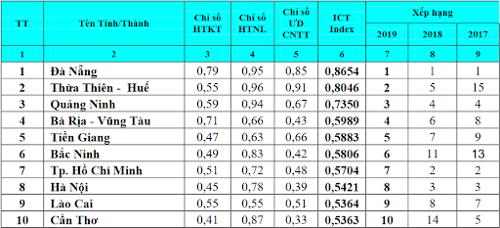 Top 10 provinces and cities at the top of the Vietnam ICT Index 2019Photo: Hangthuongvo CC 4.0 International no changes made
Top 10 provinces and cities at the top of the Vietnam ICT Index 2019Photo: Hangthuongvo CC 4.0 International no changes made
Information and communication technology is becoming increasingly important for the economic development of Vietnam and the government is investing a lot of money in it. The Vietnamese consumer mainly buys domestically produced computers and imported generic computers.
Due to its very low cost structure, Vietnam is an attractive market for multinationals in the software industry. In the outskirts of Ho Chi Minh City, the software park Qua Trung Software City has been realized, where many Vietnamese but also a few dozen foreign companies have settled.
One of the fastest growing sectors is telecommunications. The mobile phone market is very profitable.
Traffic
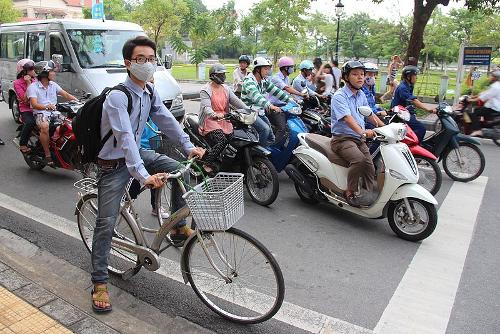 Traffic in VietnamPhoto: Peter van der Sluijs CC 3.0 Unported no changes made
Traffic in VietnamPhoto: Peter van der Sluijs CC 3.0 Unported no changes made
The south in particular has an extensive road network, which measures a total of 105,000 km and of which only 65% is paved. Very popular means of transport are motorcycles and mopeds. The car is increasingly popular as a means of transport. Most cars are bought by private companies, taxi companies and government agencies. Private individuals only have a limited share in all purchases.
Vietnam's railway network has a length of more than 3,000 kilometers and approximately 260 stations. The vast majority of all railway lines are single-track.
The Ho Chi Minh City-Hanoi railway line is of great importance to traffic.
In the expanded Mekong Delta, inland navigation is of great importance for the transport of goods and people. The Mekong and the Red River, including tributaries and canals, have a total length of more than 7,000 kilometers, and both rivers have more than 30 important inland ports.
Main seaports are Saigon, Haiphong, Ho Chi Minh City and Da Nang. Saigon is the country's main port. The Vietnam Ocean Shipping Agency deals with maritime transport.
The national airline is Vietnam Airlines; Hanoi, Ho Chi Minh City and Da Nang have international airports. A number of local airports are being modernized and made accessible to international air traffic.
Sources
Krücker, F.-J. / Vietnam
Elmar
Paulzen, H. / Vietnam : mensen, politiek, economie, cultuur, milieu
Koninklijk Instituut voor de Tropen
Peterse, L. / Vietnam
Gottmer/Becht
Te gast in Vietnam
Informatie Verre Reizen
Vietnam
Cambium
Vietnam
Lannoo
Wulf, A. / Vietnam
Het Spectrum
CIA - World Factbook
BBC - Country Profiles
Last updated June 2025Copyright: Team The World of Info